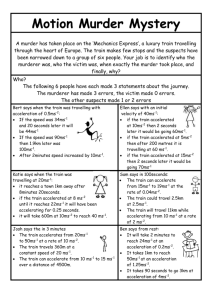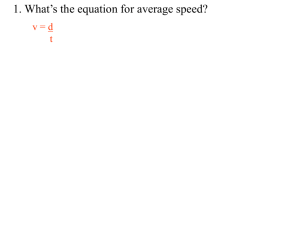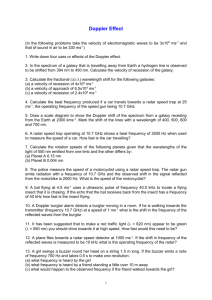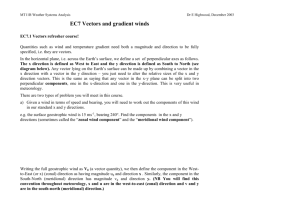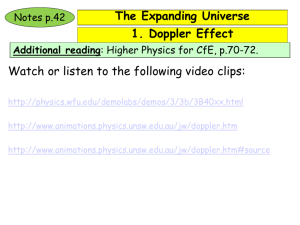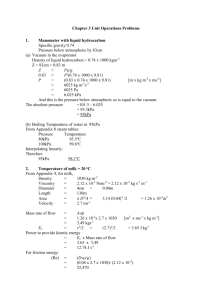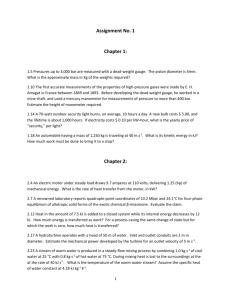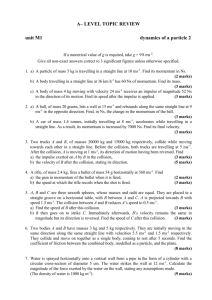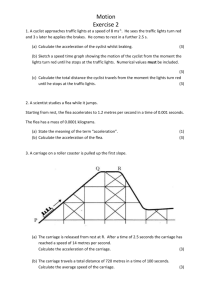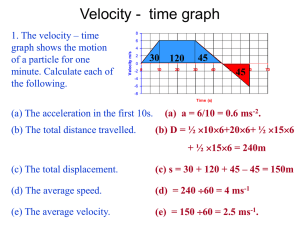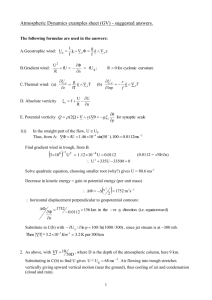Physics Exam Answers: Autumn Semester 2000-1
advertisement
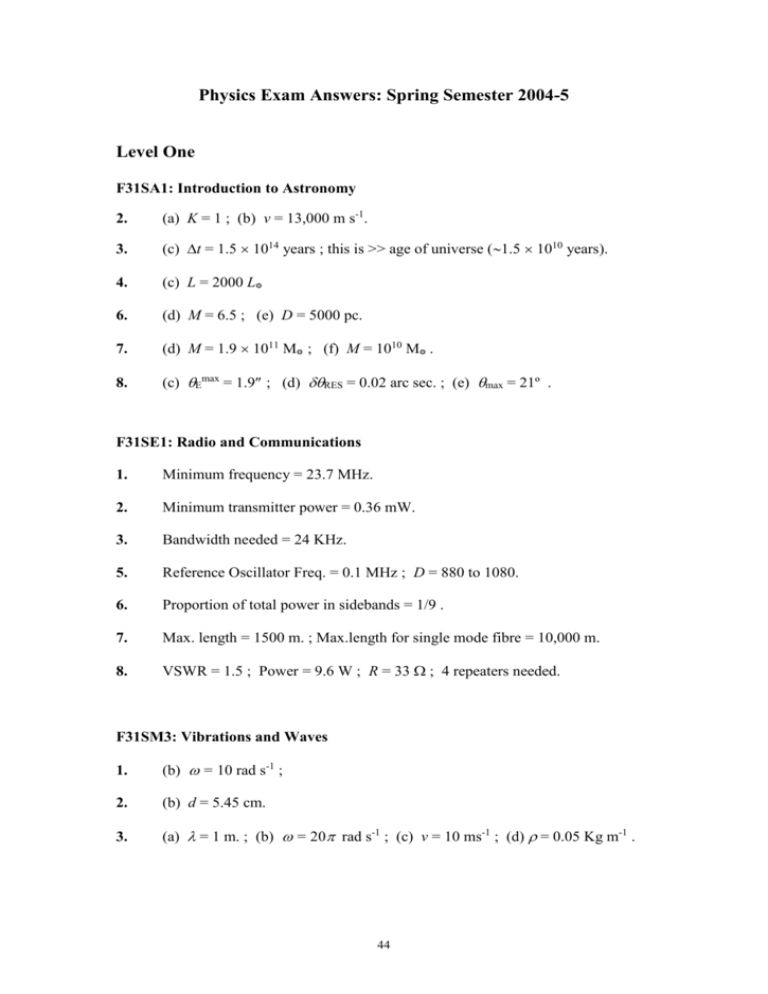
Physics Exam Answers: Spring Semester 2004-5 Level One F31SA1: Introduction to Astronomy 2. (a) K = 1 ; (b) v = 13,000 m s-1. 3. (c) t = 1.5 1014 years ; this is >> age of universe (1.5 1010 years). 4. (c) L = 2000 L๏ 6. (d) M = 6.5 ; (e) D = 5000 pc. 7. (d) M = 1.9 1011 M๏ ; (f) M = 1010 M๏ . 8. (c) Emax = 1.9 ; (d) RES = 0.02 arc sec. ; (e) max = 21º . F31SE1: Radio and Communications 1. Minimum frequency = 23.7 MHz. 2. Minimum transmitter power = 0.36 mW. 3. Bandwidth needed = 24 KHz. 5. Reference Oscillator Freq. = 0.1 MHz ; D = 880 to 1080. 6. Proportion of total power in sidebands = 1/9 . 7. Max. length = 1500 m. ; Max.length for single mode fibre = 10,000 m. 8. VSWR = 1.5 ; Power = 9.6 W ; R = 33 ; 4 repeaters needed. F31SM3: Vibrations and Waves 1. (b) = 10 rad s-1 ; 2. (b) d = 5.45 cm. 3. (a) = 1 m. ; (b) = 20 rad s-1 ; (c) v = 10 ms-1 ; (d) = 0.05 Kg m-1 . 44 F31SQ1: Space-Time and Matter 1. Ratio = 0.92 . 2. v = 2.846 108 ms-1 . 3. No. of photons per sec. = 3.01 1016 ; Kinetic energy = 4.18 eV. 4. P 5.28 10-21 kg m s-1 ; K > 52.0 keV. 5. d = 2.5 10-10 m. 6. (a) Earth recession speed = -vA ; (b) B recession speed = 7. p = 3.5 10-18 Ns ; v = 2.6 108 ms-1 . 8. Photon freq. emitted : 31 = 2.921 1015 Hz ; 32 = 4.5641 1014 Hz ; 31 = 2.46 1015 Hz ; No. of photons needed = 840. ( v A vB ) . 1 v AvB / c 2 According to Earth observer, LA = 47.7 m. and LB = 45.8 m. According to Rocket B observer, LA = 39.03 m. F31ST1: Thermal and Kinetic 2. 10 ways of arranging quanta; i.e. one oscillator has 3 and the others none (total 3); one oscillator has 2, one has 1 and the other zero (total 6); an equal sharing among the three oscillators (total 1). 4. Best efficiency is given by 1-(TL/TH) = 75%; so engineer's claim not valid. 5. Work done = P0 (V2 V1 ) 6. AB: Q = +3740 J ; W = 0 ; U = +3740 J. BC: Q = 0 ; W = -1876 J ; U = -1876 J. CA: Q = -3220 J ; W = 1111J ; U = -1901 J. α 2 2 (V2 V1 ) . 2 3 7. 8. m 2 4 (b) A = . 2kT (b) (iii) and (iv) are possible answers; (c) Total change (single stage) = +0.04C JK-1 ; Total change (two stage) = +0.04C JK-1 45 Level Two F32SA5: The Structure of Galaxies 3. 8.33 . 1/ 4 Re (b) M 1 1014 M๏ ; (c) M/L 102 M๏/L๏ . 6. (d) Rinner = 0.7 Kpc ; (e) VLOSmax = 180 Km s-1 . 7. (d) ΔV ≈ 106 ms-1 ; (e) R 2 × 1014 m. (g) D ≤ 50Mpc. 8. V (a) constant of prop. = 0 ; (c) Grav. Pot. = V02 ln r ; (d) Infinite energy. G 1. A C 2.5 log 10 I e 8.33 ; B 2 F32SB3: Molecular Biophysics 1. r0 = 0.147 10-9 m. 2. [DHAP] 96.26% ; [GA3P] 3.74%; Rate increased by factor of 2.344 3. K= 4. Separation of multiplets = 250 Hz. 5. Net charges: low pH +2, neutral 0, high pH -2. 6. Diffusion distance 0.9 mm. ; equilibrium current = 3.14 10-22 Mol m-2 s-1. 7. Phase difference = a [ h + k + l ]. 8. Number of generations = 8. S ASB F32SO1: Optics 1. Focal length = 0.35 m. ; lateral magnification = 2.34. 2. Angular diameter of star 2.67 10-7 rad. 3. Angular magnification = -20. 4. Transmittance = 97.2 %. 6. Image formed 0.0455 m. behind sphere; lateral magnification = -0.273 . 46 7. Free spectral range = 0.125 Å . 8. Distance between missing fourth order maxima = 10.92 mm. ; Slit separation = 400 m. ; irradiance I1/I0 = 0.81 and I2/I0 = 0.405 . F32SQ2: Quantum Physics 2 2 1. m e2 me2 . E Angular momentum in ground state = 0 ; ; 1 2 2 40 40 2 2. 2.79455 eV; 2.79460 eV; 2.79466 eV; 2.79472 eV; 2.79478 eV; 2.79484 eV; 2.79489 eV. 5. J = 1, 2, 2 and 3. There are 3 possible transitions to a J = 3 level of another configuration. 6. u(x, y, z) = x + iy is an eigenfunction of L̂ z with eigenvalue +1. For u(r, , ), Value of observable for L̂ z is -1 and for L̂2 is +2, giving l = 1. 7. Splitting of Sodium doublet is 2.15 10-3 eV. 8. Mass ( 168O ) = 15.9939 u . Energy to remove neutron = 16.55 MeV. Binding energy per nucleon ( 208 82 Pb ) = 7.734 MeV/nucleon. F32YT2 Thermal and Statistical Physics 1. Z = 435. 2. S = 1.11 10-22 JK-1 ; no. of accessible states changes by factor of 3139. 4. Prob. of all six correct is 7.15 10-8 ; prob. of all six incorrect is 0.436. 5. Latent heat of sublimation of zinc = 13 104 J mol-1. 6. T2 = 42.86 K ; work per cycle = 8.7 J. 7. 2 Ik T S = k B ln 2B k B ; C = kB ; I = 2.8 10-47 kg m2 ; ħ2/2I = 2 10-22 J ; T 13 K. 1 8. kEVT N n N n F = nEV k BT N ln ln ; n N e B 1 . N n 47 Level Three F33SA7: Extreme Astrophysics 3. (a) T 2 107 K ; peak 1.5 Å. 4. Sun: Pmin 9900 s. ; white dwarf: Pmin 15 s. ; neutron star: Pmin 0.5 ms. 5. (b) peak, AGN = 162 Å. 6. (b) ne 530 electrons per m3 ; Mtotal 5 1013 M๏; (c) cooling time 1011 years. 7. (a) M < 1.4 108 M๏ ; (b) M > 7 107 M๏ ; M 1600 Earth masses per day ; (d) Ratio of quaser energy to binding energy 800. 8. (c) Energy = 173 KeV. F33SB6: Functional Imaging 3. Detector pitch = 6. 4. (b) Mean transit time = 9.09 s. 5. Corrected count = 2000. 6. = 1.12 ; Q/V = 0.554 . 8. Volume required = 0.71 ml. ; percentage uptake = 10.3 % . F33SN5: Theoretical Elementary Particle Physics 1. r 4 10-16 m. 6. (b) Eigenvalue is +1 ; massless particle identified with neutrino. 7. M (d) Ratio of rates = K M 8. (d) mq = (mn + m)/6 ; A = 2 mq2 (m - mn)/3 . 5 tan 2 C ; (e) Ratio of rates = 48 MK M 5 tan 2 C . F33SO2: Laser Physics and Matter-Light Interactions 1. u = 1.5 108 ms-1 ; = 4 105 m-1 . 2. d = 1.6 m. 3. Energy = 35.3 meV ; = 7.2 ps. 4. B = 0.31 T. 6. = 3.4 104 m-1 ; Max. contribution to n for = -/2 where nmax = 4 104. 7. Assuming materials A and B are chosen for lenses 1 and 2 respectively, then r11 = r12 = r21 = 8.6 cm. and r22 = -3.6 m. 8. Min. pulse duration = 12 10-15 s. and repetition rate = 75 MHz. Average power output = 2.19 W and energy per pulse = 29 nJ; E = 47.5 MV m-1. F33SQ6: Magnetic Resonance 1. n/N = 6.8 10-6 . 4. (a) = 7.3 ppm ; (c) Resonant frequency = 25.11 MHz . 6. T1 = 721 ms ; (e) 9.29 10-9 s. and 0.67 10-9 s. 7. (b) Eigenvalues: |1 : (-h0 - X/4) ; |2 : 0 ; |3 : X/2 ; |4 : (h0 - X/4) . (c) E13 = h0 + 3X/4 ; E43 = h0 - 3X/4 . (d) Lines have equal intensity. F33SS2: Solid State Physics 2 1. vg = 0 at k = /a . 4. Highest energy phonon mode has energy 33meV. 5. I = 100 A. 7. Ed = 28 meV ; radius of ground state orbit = 2 nm. 8. vc = 26.5 ms-1 . 49 F33SV3: Atmospheric Physics and Meteorology 1. c = - 0.2 ms-1 . 2. 0* = 0.94 . 6. Total ozone in column = 270 D.U. 8. Average current from cloud to ground of -0.87 A. 9. (e) u = 1.07 ug at z = 1540 m. ; v = 0.32 ug at z = 513 m. 50
